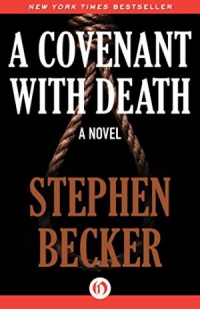A Covenant with Death by Stephen Becker
 Sunday, April 3, 2016 at 9:22AM
Sunday, April 3, 2016 at 9:22AM 
First published in 1964; published by Open Road Media on January 12, 2016
A Covenant with Death stands as one of the finest fictional explorations of the nature of justice in the history of American literature. It is a passionate story of justice gone wrong, a reminder of the consequences that follow when people are too eager (as they often are) to sit in judgment.
The covenant in the title is that between government and the governed. The governed consent to be bound by the law; the government agrees to impose the law justly. A Covenant with Death is the story of a judge who must decide how to act when the covenant is broken by both the government and the governed.
Louise Talbot was murdered in Soledad City in 1923. Forty years later, Old Judge Lewis, who was then Young Judge Lewis, provides the voice that explains the events that followed her death. Ben Lewis is an entertaining narrator who peppers the story with recollections of the town’s hypocrisies, conflicts, and idiosyncrasies. Lewis has an insightful mother of Mexican heritage and employs a Native American clerk, none of which seems to trouble town residents as much as it does outsiders, particularly outsiders who want to enforce Prohibition, an effort that Judge Lewis does his best to thwart.
Louise’s husband Bryan is indicted for her murder on scant but scandalous evidence. Without wasting time, Stephen Becker moves the novel to Bryan Talbot’s trial. “All the normal hostilities of an American town” come to a halt as town residents focus their hostility on Talbot. He is the common enemy who brings solidarity to the town and makes everyone feel virtuous by comparison.
Theatrics are often my favorite part of a courtroom drama, and Talbot’s defense attorney, a sly man named Parmalee, is a master showman. But trial scenes appear only in the novel’s first half, surrounded by Lewis’ attempts to understand his feelings for a woman named Rosemary and for another named Rafaela. Since his feelings are dominated by lust, they are not difficult to understand, but whether they might also involve love, or why they do not, and whether Lewis is careless with the affections of both women, are more perplexing questions.
The last half of the novel, the half that gives the novel its heart, begins in the aftermath of the trial. It begins with a shock, followed by another. If forces young Judge Lewis to make the most difficult decision of his career, a decision for which the law provides no clear guidance. He must look elsewhere to make a decision, beginning with himself, because “if you have to judge, judge yourself first.”
A Covenant with Death might be described as a parable of judging. What does it mean to sit in judgment of another person? How does a judge do that? How can the law and justice be balanced when they are not entirely aligned? Many novels have tried to answer those questions, but few have done so as successfully as A Covenant with Death.
Elegant prose makes A Covenant with Death stand out in the crowded world of courtroom thrillers. Lewis describes Soledad City, a southwestern town of “oily modernity” with a “gritty past,” in sufficient detail to give it life. His running commentary on “human foolishness” is amusing; his condemnation of people who do not have “the heart to walk naked on a sunny day” is wise; and his humane understanding of the difference between law and justice is inspiring.
Lewis is a good man who recognizes his faults and understands the need for humility. He is a good man whose behavior is not always exemplary but he knows that and struggles to be a better man. He knows that the law is made by full bellies, but that the world is crowded with empty bellies, “each with its pair of beseeching hands and pleading eyes.” If real judges all shared the humane values and deep understanding of the human condition that drive the fictional Judge Lewis, our judicial system would more consistently serve the needs of the governed.
RECOMMENDED
Reader Comments